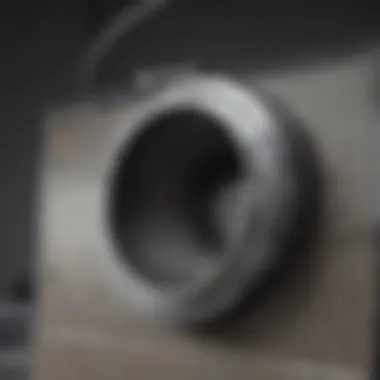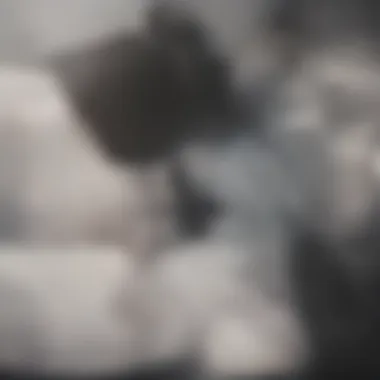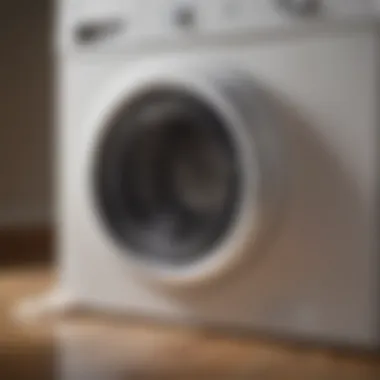Essential Techniques for Lint Removal in Dryers


Intro
Removing lint from dryers is not just a routine chore; it is essential for safety and efficiency. Lint, primarily made up of tiny fibers shed from your clothes, can accumulate quickly in dryer vents, filters, and ducts. This accumulation can lead to reduced airflow, making the dryer less efficient, and increasing energy costs. More importantly, lint buildup poses a significant fire risk. Understanding effective methods for lint removal can enhance dryer performance and minimize hazards. This article delves deeper into the importance of lint management and practical strategies to ensure your dryer operates at its best.
Feature Spotlight
Importance of Regular Maintenance
Regular maintenance of dryer lint removal systems is crucial. Cleaning the lint screen before or after each load is one recommended practice. This simple action improves air circulation and can reduce drying times significantly. But that's just the beginning.
In addition to lint screens, be aware of exhaust ducts and vent locations. These areas are often overlooked and can harbor significant amounts of lint. Inspecting and cleaning them periodically is essential for maintaining dryer efficiency. Consider using a flexible lint removal brush designed for this purpose. These brushes can easily reach into ducts, providing thorough cleaning.
Strategies for Effective Lint Removal
- Manual Cleaning: For lint screens, a quick swipe with your hand or a soft brush can be effective. For deeper cleaning, remove the screen and wash it with soap and water.
- Vacuuming: Use a vacuum with a narrow attachment to reach into the lint trap and ducts. This method is effective in removing significant lint accumulations.
- Professional Cleaning: If you notice persistent issues, consider hiring professionals. They have specialized equipment designed for deep cleaning dryer vents and ducts.
- Vent Inspection: Regularly check the outside vent to ensure it opens and closes correctly. A blocked vent can lead to excessive lint buildup.
"Regular maintenance is not just a choice for home management; it’s fundamental for ensuring the safety and efficiency of your dryer."
Safety Implications
Neglecting lint removal can lead to severe consequences. According to the National Fire Protection Association, dryers cause thousands of home fires each year, and lint is often the culprit. By adopting consistent and effective lint management practices, homeowners can greatly reduce the risk of such incidents. Therefore, periodic inspection and cleaning of not only the lint trap but also the venting systems and ducts are necessary for a safe home environment.
In summary, appropriate attention to lint removal from your dryer is a matter of safety and appliance efficiency. By implementing the strategies outlined, homeowners can enjoy peace of mind and enhanced dryer performance.
Understanding Lint Accumulation
Understanding lint accumulation is crucial for maintaining dryer efficiency and preventing hazards. Lint is the residue that builds up in the dryer, mostly made of fabric fibers, hair, and dust. Over time, this accumulation can obstruct airflow and pose serious risks, including fire hazards and diminished performance of the appliance. Awareness about lint, its formation, and the factors that contribute to its production is the starting point for effective management strategies.
What is Lint?
Lint refers to small particles or fibers shed from fabrics during the washing and drying cycles. It occurs in various forms, ranging from fine dust-like materials to larger clumps. In essence, lint is a byproduct of everyday fabric usage. Every time garments are subjected to friction, heat, or movement, tiny fibers detach. These particles can quickly accumulate if not properly managed, leading to inefficiencies in the appliance.
The Formation Process of Lint
The formation of lint occurs primarily during the washing and drying processes. When clothes are washed, the spinning action causes fibers to loosen. After this, the drying phase exacerbates this effect. As the dryer tumbles the clothes, more fibers are dislodged due to the heat and friction. The lint trap is designed to catch these particles. However, if it is not regularly cleaned, lint can bypass the trap and enter the dryer vent, where it continues to accumulate.
Factors Influencing Lint Production
Several factors influence the amount of lint generated during laundry cycles:
- Fabric Types: Some materials, such as cotton and wool, tend to shed more fibers compared to synthetics like polyester.
- Washing and Drying Methods: Higher spin speeds in washing machines and prolonged drying times can increase lint production.
- Frequency of Use: A dryer used frequently will naturally accumulate more lint over time.
- lint filter maintenance: Clean filters reduce chances of lint buildup.
The Hazards of Lint Buildup
Lint buildup in dryers is not just an annoyance; it poses significant hazards that can affect both the safety and efficiency of this critical home appliance. Understanding these hazards informs homeowners about the urgency of regular dryer maintenance. The three primary risks associated with lint accumulation are fire hazards, reduced efficiency, and adverse impacts on clothing quality. Recognizing these risks allows for proactive measures to mitigate them, ensuring safe and effective operation of dryers.
Fire Risks Associated with Lint
One of the most alarming risks linked to lint buildup is the potential for fires. Lint is highly combustible and can easily ignite if it gets too hot. When lint accumulates in the dryer vent or lint trap, it restricts airflow. This restriction leads to overheating, as the dryer has to work harder to expel moisture from clothes. According to the U.S. Fire Administration, failure to clean the dryer is a leading cause of home fires. It is crucial for homeowners to recognize the importance of regular lint removal.


"Cleaning your dryer lint trap and vent regularly could significantly reduce the risk of fire hazards in your home."
Reduced Dryer Efficiency
Another consequence of lint buildup is reduced dryer efficiency. As lint accumulates in the lint trap and vent, it obstructs airflow, making the dryer work harder. Increased drying times are often the first sign of a problem. Homeowners may notice that clothes come out damp after a typical drying cycle, leading to repeated drying sessions. This inefficiency wastes energy and can increase utility bills over time. Regular maintenance, including cleaning the lint filter after each use, is essential to maintaining efficiency. It can prolong the lifespan of the dryer as well.
Impact on Clothing Quality
Lint buildup can also impact the quality of the clothing being dried. Fabrics can become damaged due to the heat from an overheated dryer or from friction when clothes tumble against one another in a restricted airflow environment. Additionally, lint that escapes can cling to clothing, leaving unsightly fuzz and requiring extra effort to remove during laundry. Proper dryer maintenance ensures that clothes are treated gently, maintaining their quality and appearance over time.
Routine Maintenance Strategies
Maintaining a dryer requires a proactive approach. Routine maintenance strategies ensure your appliance runs effectively and safely. This is particularly vital given the fire hazards associated with lint accumulation. Regular upkeep not only enhances dryer performance but also extends its lifespan. By integrating some easy practices into your routine, you can prevent major issues down the line.
Cleaning the Lint Filter
Cleaning the lint filter is perhaps the most basic yet essential step in lint management. Before each use, it is crucial to remove any lint build-up from the filter. A clean filter allows for proper airflow, which improves dryer efficiency. This simple act can significantly decrease drying times, using less energy and preserving the quality of your clothing.
Steps for cleaning the lint filter:
- Remove the filter from the machine
- Use your fingers to remove lint clumps
- Wash the filter with mild soap and water to eliminate any residue
- Dry the filter thoroughly before reinserting it.
Maintaining a clean filter does more than just enhance performance; it also minimizes the risk of fires caused by lint being trapped in the drying cycle.
Inspecting the Vent System
Regular inspection of the vent system is equally important. The vent is responsible for carrying hot air and lint out of your home. Over time, it can become a site of accumulation itself, leading to blockages that not only affect dryer efficiency but can create highly hazardous conditions.
Key areas to check during an inspection include:
- The exterior vent cap: Ensure it opens easily. If blocked, air will not flow correctly.
- The ductwork: Look for any visible lint build-up. If there are kinks or bends, they may need adjustment.
- The connection points: Ensure all sections are securely fastened to avoid gaps where lint can escape.
By performing these checks, homeowners can prevent dangerous situations and improve the overall efficiency of the dryer.
Routine Professional Checks
Lastly, consider scheduling routine professional checks. While many homeowners can perform basic maintenance, trained technicians bring expertise that can identify potential issues you might overlook. They will do a thorough examination of the dryer and venting system, providing services like deep cleaning of the vent duct, which is often hard to reach.
Benefits of professional checks include:
- Thorough cleaning that goes beyond regular maintenance
- Identification of wear and tear that may require repair
- Advice on proper usage to ensure longevity
Incorporating these professional assessments into your maintenance paradigm can yield substantial benefits, enhancing the safety and efficiency of your dryer.
Effective Lint Removal Techniques
The effective removal of lint from dryers is essential for maintaining appliance safety and performance. Lint can accumulate in various parts of the dryer, especially in the lint trap and exhaust system. Without regular cleaning, this buildup can lead to reduced dryer efficiency, longer drying times, and increased fire risks. Understanding effective techniques for removing lint can help homeowners prolong the lifespan of their appliances while ensuring safe operation.
Manual Cleaning Methods


Using a Vacuum Cleaner
A vacuum cleaner is a powerful ally in the battle against lint accumulation. The high suction capability of a vacuum cleaner enables it to effectively remove lint from the lint trap and dryer vent. Not only can it clean visible lint, but it can also access hard-to-reach areas.
One key characteristic of using a vacuum cleaner is its versatility. It can be utilized for a variety of cleaning tasks beyond lint removal, making it a worthwhile investment for home maintenance. However, one must be careful about the vacuum’s attachment used. A narrow hose attachment can work well for precision cleaning.
The unique advantage of vacuuming lint is that it is quick and efficient. On the downside, if not used correctly, a vacuum can potentially damage delicate lint filters. Therefore, it is crucial to handle the vacuum with care to prevent any mishaps.
Employing Soft Brushes
Employing soft brushes can complement vacuuming when removing lint. A soft brush is particularly useful for dislodging lint stuck in mesh filters and hard surfaces. It is gentle enough not to cause any damage while providing a thorough clean.
The key characteristic of a soft brush lies in its design. These brushes are typically made with fine bristles that effectively capture lint without scratching the dryer surfaces. This gentle approach is beneficial for those worried about harming their appliances.
A distinct advantage of using soft brushes is their ability to reach confined spaces that might be inaccessible to other cleaning tools. However, they can take more time and effort compared to vacuuming, which may deter some users. That said, combining the two methods can lead to optimum results.
Utilizing Dryer Cleaning Kits
Dryer cleaning kits are specifically designed to tackle lint buildup and can greatly simplify the cleaning process. These kits usually include specialized brushes and tools made for cleaning dryer vents and lint traps. Their design allows for cleaning in various angles and tight spaces.
These kits are particularly strong because they come tailored for the job at hand. Additionally, many kits contain instructions for proper use, which can help those less experienced with dryer maintenance. The downside, however, is that they can require an initial investment, which might not appeal to everyone.
Professional Cleaning Services
For those looking for a comprehensive lint removal solution, professional cleaning services offer a robust option. These services provide thorough inspections and deep cleaning of dryer vents and lint ducts, ensuring no lint is left behind.
The advantage of hiring professionals is their expertise and access to advanced cleaning tools that can remove lint more effectively than standard home cleaning methods. Moreover, they can identify potential hazards, such as blockages, before they escalate into more significant issues. However, this option tends to be more costly than DIY methods, and scheduling their services could be a hindrance for some homeowners.
"Regular cleaning of dryer vents and lint traps is crucial for safety and efficiency. Ignoring this task can lead to dangerous outcomes."
Innovative Tools for Lint Management
The accumulation of lint in dryers poses risks beyond just appliance inefficiency. Innovative tools for lint management have emerged as pivotal solutions, enhancing both cleaning efficiency and safety in the home. These tools help in minimizing hazards and ensuring that dryers operate smoothly, thus prolonging their lifespan.
Lint Trap Accessories
Lint trap accessories are essential tools that assist in the effective gathering and disposal of lint during dryer use. These accessories enhance the functionality of standard lint traps, ensuring that no trapped lint escapes into the duct system.
Some common types of lint trap accessories include:
- Lint brushes: Designed for deep cleaning, these long-handled brushes can reach areas inside the lint trap that are difficult to access.
- Lint screen cleaners: These tools effectively clear out stubborn lint debris that may cling to the screen, improving ventilation.
- Vent brushes: These attachments can be connected to vacuums to clear lint buildup from the vent ducts.
By incorporating lint trap accessories, users can drastically reduce lint-related hazards and improve dryer efficiency. Regular use of these tools helps prevent clogs that can decrease airflow and lead to overheating.
Smart Technology Solutions
Smart technology solutions represent the cutting edge in lint management, offering not just cleaning, but monitoring capabilities. These products could include smart sensors or automated lint removal systems, which optimize dryer performance by gathering data and alerting users to issues before they escalate.
Examples of smart technology solutions:


- Lint monitoring sensors: These devices alert users through smartphone apps when lint buildup reaches a critical level, prompting timely intervention.
- Connected dryer systems: Some modern dryers come equipped with integrated cleaning options that manage lint removal automatically.
- Airflow sensors: These track airflow efficiency, signaling when vents need cleaning to maintain optimal dryer performance.
The implementation of smart technology not only simplifies the maintenance process but also fosters energy efficiency. By enabling proactive lint management, these tools ensure that the dryer operates under optimal conditions, thereby reducing energy consumption and enhancing safety.
Effective lint management not only protects the appliance but also has implications for energy efficiency in the home.
Incorporating these innovative tools into a lint management routine can significantly reduce fire risks, improve dryer efficiency, and mitigate clothing damage. By staying ahead with modern solutions, homeowners can maintain a safer and more efficient drying process.
Environmental Impact of Lint Waste
The accumulation of lint in dryers raises significant ecological concerns that are often overshadowed by discussions on safety and appliance efficiency. Understanding how lint affects the environment is crucial for a holistic approach to dryer maintenance. Lint, primarily composed of natural and synthetic fibers, can contribute to waste and pollution if not managed properly. The environmental impact is multifaceted, involving issues of material waste and energy consumption.
Recycling Lint Materials
Recycling lint is an avenue worth exploring for both environmental sustainability and resource management. The fibers collected from dryer lint traps can often be recycled, though most households do not consider this option. Many recycling facilities accept textile waste, and lint can be converted into raw materials for various applications. For instance, lint can be processed to make insulation for houses, packing materials, and even biodegradable products.
- Benefits of Recycling Lint:
- Reduces landfill waste.
- Decreases the need for new raw materials.
- Promotes sustainable consumer practices.
To encourage proper disposal, it’s important to differentiate which lint materials are recyclable. Cotton and wool lint can often be processed, whereas synthetic fibers may not be suitable for all recycling programs. Therefore, households should check their local recycling guidelines. Emphasizing this can raise awareness and drive community participation in recycling initiatives.
Energy Efficiency Considerations
The energy efficiency of dryers interacts closely with the generation of lint. When lint builds up in the dryer or vent system, it obstructs airflow, forcing the appliance to consume more energy to function effectively. This inefficiency not only raises utility bills but also impacts the carbon footprint of each load of laundry.
- Key Points on Energy Efficiency:
- Regular lint removal can enhance dryer performance.
- Ensuring clean ducts leads to optimal airflow.
- Efficient dryers consume less energy and produce fewer emissions.
Furthermore, utilizing energy-efficient dryer models can significantly mitigate the environmental impact. These appliances are designed to use less energy while maintaining performance. The benefits extend beyond personal savings, as these efficiencies contribute to broader energy conservation efforts.
For every load dried with an efficient model, you reduce energy costs and environmental effects, advocating for a sustainable future.
The End and Long-term Maintenance Advice
In summary, the maintenance of a dryer is not only pivotal for its performance but also crucial for home safety. Lint buildup can lead to efficiency loss and severe fire risks. The practices and methods discussed in this article underscore the importance of proactive maintenance strategies. Regular cleaning and checks provide both peace of mind and save on replacement costs over time.
Establishing Regular Cleaning Routines
Creating a structured cleaning routine is essential in managing lint effectively. A well-defined schedule helps ensure that lint remains under control. Here are key points to consider for establishing this routine:
- Frequency of Cleaning: Clean the lint filter after every load. This simple act significantly reduces lint accumulation.
- Deep Cleaning: Schedule a thorough cleaning of the dryer vent at least once a year. Utilize a professional service if necessary to ensure proper clearance of lint that might not be accessible through regular cleaning.
- Checklist: Maintain a checklist that includes:
- Cleaning the lint filter
- Checking the vent for blockages
- Inspecting the ductwork for any signs of wear or buildup.
These steps will not only enhance the performance of the dryer but also contribute to energy savings.
Educating Household Members
Knowledge sharing within the household regarding lint management enhances safety and efficiency. Educating every household member on the importance of lint removal can lead to better overall practices. Consider the following:
- Demonstration: Show other members how to properly clean the lint filter and inspect the vent.
- Educate on Risks: Inform them about the fire hazards associated with lint buildup, fostering a culture of care around appliance usage.
- Create a Guide: Develop a simple guide or use visual aids to remind everyone about the cleaning routines. This can be placed near the dryer for easy reference.
Ultimately, by establishing routines and educating all household members, the risks associated with lint accumulation can be significantly mitigated. A well-maintained dryer not only performs better but also promotes a safer home environment, making it a worthwhile endeavor for every household.







